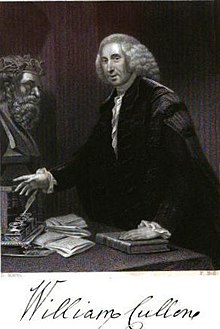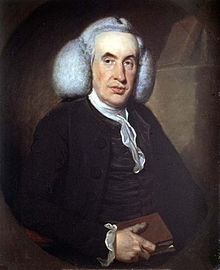William Cullen
William Cullen (born April 15, 1710 in Hamilton , Lanarkshire , † February 5, 1790 in Kirknewton / West Lothian near Edinburgh ) was a Scottish medic , country doctor , surgeon and chemist .
Live and act
Cullen studied medicine in Glasgow from 1727 and came to London in 1729. In 1730 he was a ship's doctor on a ship in the Caribbean and then from 1734 to 1736 at the University of Edinburgh. He was then a resident doctor in his hometown of Hamilton for eight years. In 1740 he received his doctorate in medicine at the University of Glasgow and was from 1744 at the University of Glasgow, where he received the first chemistry chair in Great Britain in 1747.
In 1751 Cullen Regius became Professor of Medicine and Therapeutics at the University of Glasgow , in 1755 he became Professor of Chemistry at the University of Edinburgh , where he also taught physics from 1766 and medicine from 1773. In 1773 he was appointed President of the Royal College of Physicians in Edinburgh and in 1777 he was elected Fellow of the Royal Society of London . Cullen was the successor to Robert Whytt (1717–1766). The University of Edinburgh was then considered a leader in the field of medicine in Europe. Based on the teachings of Thomas Willis (1621–1675), who was regarded as the “father of neurology” and that of Thomas Sydenham (1624–1689), Whytt had developed a theory of nerves that became the pathogenetic basis of all pathology. The empiricism of Scottish philosophy suited the successes of the natural sciences.
He is one of the founders of the Royal Society of Edinburgh and the Royal Medical Society . In 1789 he was elected a foreign member of the Göttingen Academy of Sciences .
He founded a school of chemistry in Edinburgh. One of his students in Glasgow and Edinburgh was Joseph Black . Cullen was one of the first chemists to use symbolic reaction equations (around 1758). He classified alkaline earth metals and dealt with the cleaning of table salt.
Cullen's work Synopsis Nosologicae Medicae is considered a forerunner of the ICD .
Introduction of the term neurosis
In 1776, Cullen introduced the term neurosis . This term should be used to denote all non-inflammatory diseases of the nervous system, as a distinction from neuritis . This also meant mental disorders. This does not mean that with the term neurosis coined by Cullen, a meaning of neurosis in our present-day sense was defined, for example in the sense of "consultation hour psychiatry" or small psychiatry. Rather, Cullen placed great emphasis on neurophysiology in his disease classification . Their results, which were new for the time, had triggered a Europe-wide controversy with the work of Georg Ernst Stahl (1659–1734), Friedrich Hoffmann (1660–1742) and Albrecht von Haller (1708–1777). Cullen's major works were First Lines of the Practice of Physic ; Institutions of Medicine (1784) and Synopsis Nosologiae Methodicae (1785), in which he made a nosological classification of diseases into four large groups. These groups were:
- Pyrexiae , d. H. febrile illnesses such as B. Typhoid
- Neuroses , d. H. Nervous diseases such as B. Epilepsy
- Cachexiae , d. H. Diseases with poor general physical condition ( cachexia ) such as B. Scurvy
- Locales , d. H. local causes of disease such as B. Cancer .
At that time people went over to mental illnesses such as B. to no longer localize hysteria in the uterus or to regard it as an incurable obsession. They were more and more viewed as diseases of the nervous system. Nevertheless, Cullen was criticized by Philippe Pinel because he, like Erasmus Darwin , already viewed simple vices as mental illnesses. Pinel said: "Ce serait convertir en Petites Maisons nos cités les plus florissantes." (This would mean converting our most prosperous cities into private madhouses.) With the principle of education, Cullen took a view similar to that which was even propagated by Pinel himself in Germany was mainly taken up by the group of psychics . But Pinel was more of a pragmatic character.
Artificial cooling
In 1756, Cullen experimented with diethyl ether , which he made to evaporate using negative pressure. Heat was removed from the vicinity of the reaction vessel and small amounts of ice formed. The findings of this experiment did not acquire any economic significance.
Works
- Chemical history of vegetables , 1746
- Chemical history of animals , 1746
- First Lines of the Practice of Physick, for the Use of Students , 4 volumes, (1777) German plan of medical practice for students
- Institutions of Medicine
- Lectures on the Materia medica , Lowndes, London 1772 (digitized version) ; 2nd edition Whitestone, Dublin 1781 (digitized) . German. Johann Dietrich Philipp Christian Ebeling . Weygand, Leipzig 1781 (digitized version)
- Synopsis Nosologicae Medicae (1785), a classification of diseases
- Cours de Matière médicale. Published: Volumes 1–4. Paris, 1788. urn : nbn: de: hbz: 061: 2-148946
- A treatise of the materia medica (1789); German: Treatise on Materia Medik a / translated and with comments by Samuel Hahnemann . Leipzig, Im Schwickertschen Verlage, 1790 Volume 1
- Traité de Matière médicale. Translated by Bosquillon, Édouard François Marie. Published: Volumes 1–3. Sauveur, Pavie 1791. urn : nbn: de: hbz: 061: 2-148969
- Trattato di Materia medica del Signor Gugliemo Cullen. Affiliated person: Dalladecima, Angelo. 2nd ed. Published: Volumes 1–6. Bettinelli, Padova 1798. urn : nbn: de: hbz: 061: 2-148955
literature
- Cullen, William . In: Encyclopædia Britannica . 11th edition. tape 7 : Constantine Pavlovich - Demidov . London 1910, p. 616 (English, full text [ Wikisource ]).
- George Thomas Bettany: Cullen, William . In: Leslie Stephen (Ed.): Dictionary of National Biography . Volume 13: Craik - Damer. MacMillan & Co, Smith, Elder & Co., New York City / London, 1888, pp 279 - 282 (English).
- WF Bynum: Cullen, William (1710-1790), chemist and physician. In: Henry Colin Gray Matthew, Brian Harrison (Eds.): Oxford Dictionary of National Biography , from the earliest times to the year 2000 (ODNB). Oxford University Press, Oxford 2004, ISBN 0-19-861411-X , ( oxforddnb.com license required ), as of 2004 (not viewed).
- Winfried Pötsch u. a. Lexicon of important chemists , Harri Deutsch 1989.
- Barbara I. Tshisuaka: Cullen, William. In: Werner E. Gerabek , Bernhard D. Haage, Gundolf Keil , Wolfgang Wegner (eds.): Enzyklopädie Medizingeschichte. De Gruyter, Berlin / New York 2005, ISBN 3-11-015714-4 , p. 279.
Web links
- Entry on Cullen, William (1710–1790) in the Archives of the Royal Society , London
Individual evidence
- ↑ Holger Krahnke: The members of the Academy of Sciences in Göttingen 1751-2001 (= Treatises of the Academy of Sciences in Göttingen, Philological-Historical Class. Volume 3, Volume 246 = Treatises of the Academy of Sciences in Göttingen, Mathematical-Physical Class. Series 3, volume 50). Vandenhoeck & Ruprecht, Göttingen 2001, ISBN 3-525-82516-1 , p. 63.
- ^ MP Crosland: The use of diagrams as chemical 'equations' in the lectures of William Cullen and Joseph Black . In: Annals of Science , Volume 15, 1959, pp. 75-90
- ↑ WHO (PDF; 152 kB)
- ^ Bridegroom, Walter: reactions, neuroses, psychopathies . A plan of the small psychiatry. dtv and Georg Thieme, Stuttgart 1968, page 70
- ↑ a b Erwin H. Ackerknecht : Brief history of psychiatry . Enke, Stuttgart 3 1985, ISBN 3-432-80043-6 , pages 37, 43 (a); 42 f. (b);
- ↑ Klaus Dörner : Citizens and Irre, on the social history and sociology of science of psychiatry . [1969] Fischer Taschenbuch, Bücher des Wissens, Frankfurt / M 1975, ISBN 3-436-02101-6 , pages 62–65, 67, 71, 80, 122, 152, 154f, 203
| personal data | |
|---|---|
| SURNAME | Cullen, William |
| BRIEF DESCRIPTION | Scottish medic and chemist |
| DATE OF BIRTH | April 15, 1710 |
| PLACE OF BIRTH | Hamilton (South Lanarkshire) , Lanarkshire |
| DATE OF DEATH | February 5, 1790 |
| Place of death | Kirknewton (Scotland) |

